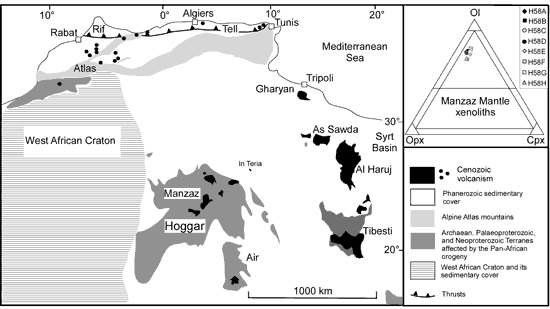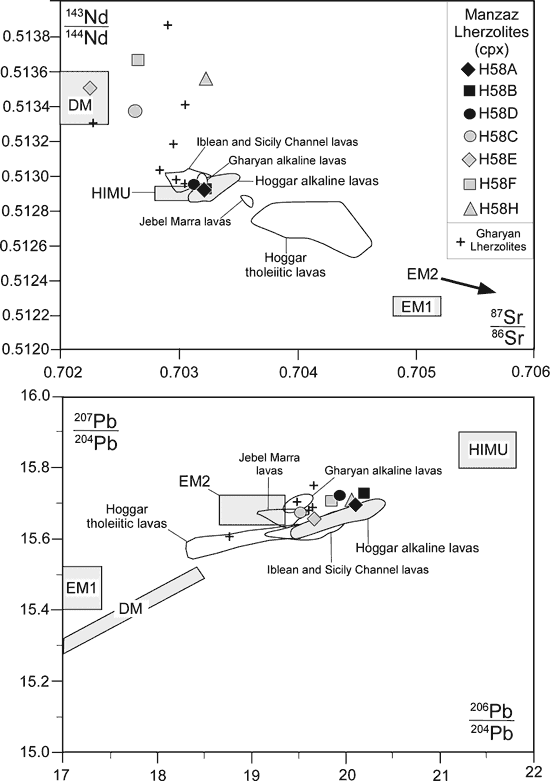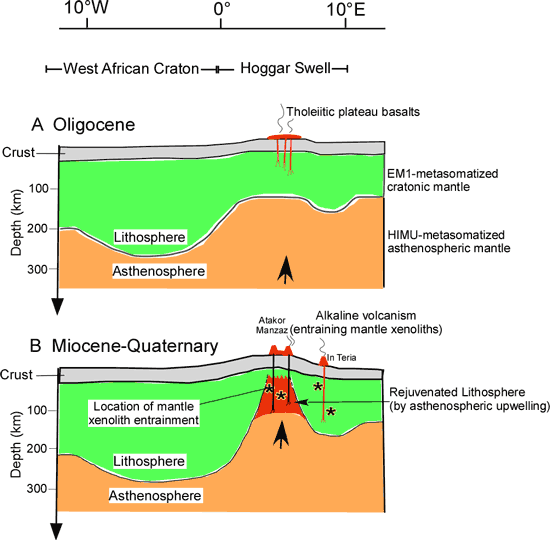 |
Asthenospheric
upwelling and lithosphere rejuvenation
beneath the Hoggar swell, Algeria: evidence
from mantle xenoliths |
L.
Beccaluva1, A.
Azzouni-Sekkal2,
A. Benhallou3, G.
Bianchini1,
R.M.
Ellam4,
M. Marzola1, F.
Siena1 and F.M.
Stuart4
1Dipartimento di Scienze
della Terra, Università di
Ferrara, Italia, bcc@unife.it, bncglc@unife.it, mrzmsm1@unife.it, snr@unife.it
2Faculté des Sciences de la Terre,
Géographie
et Aménagement du Territoire, Université des
Sciences et Technologie Houari Boumédienne,
Alger, Algérie, asazzouni@hotmail.com
3CRAAG (Centre de Recherche en Astronomie,
Astrophysique et Géophysique), Alger, Algérie, zoulema@yahoo.com
4Isotope Geoscience Unit, Scottish Universities
Environmental Research Centre, East Kilbride, UK, r.ellam@suerc.gla.ac.uk, f.stuart@suerc.gla.ac.uk
Corresponding author: Luigi
Beccaluva
This webpage is an abridged version of Beccaluva,
L., A. Azzouni-Sekkal, A. Benhallou, G. Bianchini,
R.M. Ellam, M. Marzola, F. Siena and F.M. Stuart,
Intracratonic asthenosphere upwelling and lithosphere
rejuvenation beneath the Hoggar swell (Algeria):
Evidence from HIMU metasomatised lherzolite mantle
xenoliths, Earth Planet. Sci. Lett., 260,
482-494, 2007.
 Click here to
download a PDF version of this webpage Click here to
download a PDF version of this webpage
The Cenozoic volcanism of the Hoggar
region (Algeria) represents one of the most important
magmatic areas in the north African belt [Ed: See also
the webpage The
Hoggar swell and volcanism, Tuareg shield, Central
Sahara]. It covers more than 10,000 km2 and
is associated with a regional crustal swell of Pan-African
terranes, approximately 1000 km in diameter (Figure
1). The oldest Cenozoic volcanic rocks comprise a thick
pile of tholeiitic plateau basalts (35-30 Ma) characterized
by an isotopic signature typical of EM1-type enriched
mantle (Aït-Hamou et al., 2000).
Younger (Neogene-Quaternary) volcanic rocks have an
alkaline affinity and include both basic lavas and
trachyte-phonolite differentiates, with a prevalent
HIMU (high μ) Pb-Nd-Sr isotopic signature (Allègre
et al., 1981; Azzouni-Sekkal et al.,
2007). In the Manzaz (Central Hoggar) district, the
youngest volcanic episodes are markedly alkaline (basanites
and nephelinites) and sometimes entrain the mantle
xenoliths which are the subject of this study.

Figure 1. Sketch map showing locations
of the main Cenozoic volcanic fields of north Africa,
after Liégeois et al. (2005). Modal compositions
of the Manzaz mantle xenoliths in terms of olivine
(ol), orthopyroxene (opx) and clinopyroxene (cpx)
are shown. Click here or on figure for enlargement.
The mantle xenoliths are proto-granular anhydrous
spinel lherzolites. Major- and trace-element analyses
on bulk rocks and constituent mineral phases show that
the primary compositions are widely overprinted by
metasomatic processes. Trace-element modelling of the
metasomatised clinopyroxenes allows the inference that
the metasomatic agents that enriched the lithospheric
mantle were highly alkaline carbonate-rich melts such
as nephelinites/melilitites (or extreme silico-carbonatites).
These agents were characterized by a clear HIMU Sr-Nd-Pb
isotopic signature. There is no evidence of EM1 components
which are recorded by the Hoggar Oligocene tholeiitic
basalts.

Figure 2. Sr-Nd-Pb isotopic variations
of clinopyroxenes from Manzaz mantle xenoliths. Composition
of mantle xenoliths from the Gharyan district of
Libya (Beccaluva et al., in press), and Cenozoic
alkaline lavas from various African volcanic areas,
are given for comparison: Hoggar (Allègre
et al., 1981), Jebel Marra (Davidson & Wilson, 1989;
Franz et al., 1999), Iblean - Sicily Channel Districts
(Beccaluva et al., 1998; Bianchini et al., 1998; Civetta
et al., 1998). Isotopic mantle end members (DM, HIMU,
EMI and EMII) are from Zindler & Hart (1986).
This can be interpreted as resulting
from replacement of the older lithospheric mantle,
from which the tholeiites were generated, by upwelling
asthenosphere with a HIMU signature. Accordingly, this
rejuvenated lithosphere (accreted asthenosphere without
an EM signature) may represent a possible mantle source
from which deep alkaline basic melts could have been
generated and shallower mantle xenoliths derived. The
systematic occurrence of Neogene alkaline lavas and
associated mantle xenoliths with a clear HIMU affinity
across the African plate indicates that it is a ubiquitous
sub-lithospheric component across Central-Northern
Africa. In fact this component is considered related
to the ultimate fate of subducted oceanic lithotypes
which create high U/Pb and Th/Pb mantle domains that,
after long-term storage, result in highly radiogenic
Pb compositions (Weaver, 1991; Carlson,
1995; Hofmann,
1997). Accordingly, Wilson & Patterson (2001)
physically locate this component above the 670-km discontinuity
in the upper mantle, where geophysical evidence shows
subducted slab relics flatten over wide upper-mantle
regions (e.g., in the Central Mediterranean; Faccenna
et al., 2001; Beccaluva et
al., 2005).
The available
data on the lherzolite xenoliths and alkaline lavas
(including He isotopes with R/Ra < 9) indicate
that there is no requirement for a deep plume anchored
in the lower mantle. Sources in the upper
mantle can satisfactorily account for all the geochemical,
petrological and geophysical evidence characterizing
the Hoggar swell. The relatively low 3He/4He
ratios observed for the Saharan districts are
a further indication that this metasomatic component
is confined in the upper mantle, unlike the Ethiopian-Yemen
plateau basalts (3He/4He up to
20 Ra) which have been related to a deep mantle plume
possibly generated from the core-mantle boundary (Pik
et al., 2006) [Ed: But see also Helium
Fundamentals page]. By contrast,
relatively low 3He/4He can be
satisfactorily explained by degassing of shallow mantle
domains and/or the addition of recycled components
to the upper mantle (Moreira &
Kurz, 2001).
Moreover, the lithosphere
uplift that resulted in the Hoggar swell conforms
with geophysical evidence such as the gravity field
data (Bouguer anomaly of -90 mGal; Lesquer
et al., 1988) and the thermal anomaly centred
on the Atakor volcanism (heat flow 63 mW/m2; Lesquer
et al., 1989). Seismic tomography of the mantle
beneath north Africa shows that the lithosphere thickness
in the Sahara area is variable due to local asthenospheric
upwellings (Ayadi et al., 2000) which
generally do not extend deeper than ca. 400 km, thus
precluding the existence of deep mantle plumes anchored
in the lower mantle (Davaille et al., 2000; Sebai
et al.,
2006).

Figure 3. Simplified cartoon showing
the hypothesised lithosphere/asthenophere interactions
beneath the Hoggar swell. (a) Tholeiitic plateau
basalts (35-30 Ma) formed by high degrees of melting
of EM1-metasomatised mantle of the Pan-African
cratonic lithosphere. (b) Younger alkaline volcanism
of the Atakor-Manzaz area generated from low degrees
of melting of HIMU-metasomatised mantle sources.
The latter probably represents a rejuvenated lithosphere
formed by intra-cratonic upwelling and accretion
of asthenopheric material. The Manzaz spinel lherzolite
xenoliths may therefore represent fragments of this
rejuvenated lithosphere, whereas the garnet/spinel
peridotite xenoliths from In Teria (Dautria et al.,
1992) may represent the older cratonic mantle of
the Pan-African lithosphere.
In conclusion, convection in the upper
mantle and lithosphere/asthenosphere interactions mainly
along lithospheric discontinuities such as craton/mobile
belt borders, as proposed by the edge-driven convection
model (King & Anderson, 1995;
1998) is the most appropriate geodynamic scenario for
the mantle evolution of the Hoggar swell.
Hoggar volcanism,
as well as other volcanism in the Saharan belt, is
thus probably related to passive asthenospheric mantle
upwelling and decompression melting linked to extensional
stresses in the lithosphere during Cenozoic reactivation
and rifting of the Pan-African basement. This can be
considered a far-field foreland reaction to the Africa-Europe
collisional system subsequent to the Eocene.
References
-
Aït-Hamou F., Dautria
J.M., Cantagrel J.M., Dostal J., Briqueu L., 2000.
Nouvelles données géochronologiques
et isotopiques sur le volcanisme cénozoïque
de l'Ahaggar (Sahara algérien): des arguments
en faveur d'un panache. Comptes Rendus de l'Académie
des Sciences de Paris 330, 829-836.
-
Allègre
C.J., Dupré B., Lambert B., Richard
P., 1981. The sub-continental versus sub-oceanic
debate. Lead-neodymium-strontium isotopes in primary
basalts in a shield area: the Ahaggar volcanic
suite. Earth
Planet. Sci. Lett. 52, 85-92.
-
Ayadi
A., Dorbath C., Lesquer A., Bezzeghoud M., 2000.
Crustal and upper mantle velocity structure of the
Hoggar swell (Central Sahara, Algeria). Physics
Earth Planet. Int. 118,
111–123.
-
Azzouni-Sekkal
A., Bonin B., Benhallou A., Yahiaoui R., Liégeois
J.-P, 2007. Tertiary alkaline volcanism of the
Atakor Massif (Hoggar, Algeria). In: L. Beccaluva,
G. Bianchini, M. Wilson (Eds), Cenozoic volcanism
in the Mediterranean Area, Geological Society
of America (GSA) Special Paper 418, 321-340.
-
Beccaluva
L., Siena F., Coltorti M., Di Grande A., Lo Giudice
A., Macciotta G., Tassinari R., Vaccaro C., 1998.
Nephelinitic to tholeiitic magma generation in a
transtensional tectonic setting: an integrated model
for the Iblean volcanism, Sicily. J. Petrol. 39,
1547-1576.
-
Beccaluva L., Bianchini G., Coltorti M., Siena
F., Verde M., 2005. Cenozoic tectono-magmatic evolution
of the central-western mediterranean: migration of
an arc-interarc basin system and variations in the
mode of subduction. In: Finetti, I. (Ed), Elsevier
special volume, Crop Project
- Deep Seismic Exploration of the Central Mediterranean
and Italy,
pp 623-640.
-
Beccaluva,
L., A. Azzouni-Sekkal, A. Benhallou, G. Bianchini,
R.M. Ellam, M. Marzola, F. Siena and F.M. Stuart,
Intracratonic asthenosphere upwelling and lithosphere
rejuvenation beneath the Hoggar swell (Algeria):
Evidence from HIMU metasomatised lherzolite mantle
xenoliths, Earth Planet. Sci. Lett., 260,
482-494, 2007.
-
Beccaluva
L., Bianchini G., Ellam R.M., Marzola M., Oun K.M.,
Siena F., Stuart F.M., in press. The role of HIMU
metasomatic components in the African lithospheric
mantle: petrological evidence from the Gharyan
peridotite xenoliths, NW Libya. In M. Coltorti,
M. Grégoire
(Eds.) Mantle metasomatism in intra-plate and suprasubduction
settings, Geological Society, Special Publication,
293, 253-277.
-
Bianchini G., Clocchiatti R., Coltorti
M., Joron J.L., Vaccaro C., 1998. Petrogenesis of
mafic lavas from the northernmost sector of the Iblean
District (Sicily). Eur.
J. Mineral. 10, 301-315.
-
Carlson R.W., 1995. Isotopic inferences on the
chemical structure of the mantle. J.
Geodynamics 20, 365-386.
-
Civetta
L., D'Antonio M., Orsi G., Tilton G.R., 1998. The
geochemistry of volcanic rocks from Pantelleria island,
Sicily Channel: petrogenesis and characteristics
of the mantle source region. J. Petrol. 39,1453-1492.
-
Dautria
J.M., Dupuy C., Takherist D., Dostal J., 1992. Carbonate
metasomatism in the lithospheric mantle: peridotitic
xenoliths from a melilititic district of the Sahara
basin. Contrib. Mineral. Petrol. 111,
37-52.
-
Davaille A., Stutzmann E., Silveira
G., Besse J., Courtillot V., 2005. Convective patterns
under the Indo-Atlantic. Earth
Planet. Sci. Lett. 239, 233-252.
-
Davidson
J.P., Wilson I.R., 1989. Evolution of an alkali basalt-trachyte
suite from Jebel Marra volcano, Sudan, through assimilation
and fractional crystallization. Earth
Planet. Sci. Lett. 95, 141-160.
-
Faccenna C., Funiciello F., Giardini D., Lucente
P., 2001. Episodic back-arc extension during restricted
mantle convection in the Central Mediterranean. Earth
Planet. Sci. Lett. 187, 105-116.
-
Franz
G., Steiner G., Volker F., Pudlo D., Hammerschmidt
K., 1999. Plume related alkaline magmatism in central
Africa - the Meidob Hills (W Sudan). Chem. Geol. 157,
27-47.
-
Hofmann A.W., 1997, Mantle geochemistry: the message
from oceanic volcanism. Nature 385,
219-229.
-
King S.D., Anderson D.L., 1995. An
alternative mechanism of flood basalt formation. Earth
Planet. Sci. Lett. 136,
269-279.
-
-
Lesquer
A., Bourmatte A., Dautria J.M., 1988. Deep structure
of the Hoggar domal uplift (Central sahara, south
Algeria) from gravity thermal and petrological data. Tectonophysics 152,
71-87.
-
Lesquer A., Bourmatte A., Ly S., Dautria
J.M., 1989. First heat flow determination from the
Central Sahara: relationshipswith the Pan-African
belt and Hoggar domal uplift. J. African Earth Sc. 9,
41-48.
-
Liégeois J.P., Benhallou
A., Azzouni-Sekkal A., Yahiaoui R., Bonin B., 2005.
The Hoggar swell and volcanism: Reactivation of
the Precambrian Tuareg shield during Alpine convergence
and West African Cenozoic volcanism. In: G.R. Foulger,
J.H. Natland, D.C. Presnall, D.L. Anderson (Eds.), Plates, Plumes,
and Paradigms,
Geological Society of America (GSA) Special Paper
388, 379-400.
-
Moreira M., Kurz M. D., 2001.
Subducted oceanic lithosphere and the origin of
the `high µ´ basalt
helium isotopic signature. Earth
Planet. Sci. Lett. 189, 49-57.
-
Pik R., Marty B., Hilton D.R., 2006. How many plumes
in Africa? The geochemical point of view. Chem.
Geol. 226, 100-114.
-
Sebai A., Stutzmann E., Montagner
J.-P., Sicilia D. et al., 2006. Anisotropic structure
of the African upper mantle from Rayleigh and Love
wave tomography. Physics
of the Earth and Planetary Interiors 155,
48-62.
-
Weaver B.L., 1991. The origin of ocean island basalt
end-member compositions: trace element and isotopic
constraints. Earth Planet. Sci.
Lett. 104, 381-397.
-
Wilson M.,
Patterson R., 2001. Intraplate magmatism related
to short-wavelength convective instabilities in the
upper mantle: Evidence from the Tertiary-Quaternary
volcanic province of Western and Central Europe.
In: R.E. Ernst, K.L. Buchan (Eds.) Mantle
plumes: their identification through time,
Geological Society of America (GSA) Special Paper
352, 37–58.
-
Zindler A., Hart S.R., 1986. Chemical
Geodynamics. Earth
and Planetary Sciences, Annual Review, 14,
493-571.
last updated 23rd
September, 2007 |
